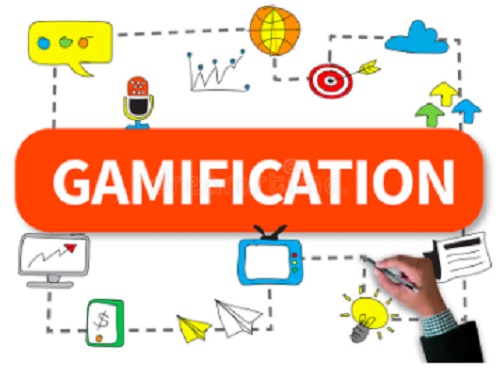Gamification
Definition
Gamification refers to adding game-like elements, such as points, badges, leaderboards, and challenges, to non-game contexts, such as education, marketing, and workplace activities.
Description
It aims to increase user engagement, motivation, and retention by tapping into people’s natural desires for competition, achievement, and social interaction. As a result, it often enhances learning, behaviour change, customer loyalty, and employee productivity.

It leverages the psychological principles that underlie games. By incorporating elements such as points, badges, leaderboards, and challenges into non-game contexts, gamification creates a more immersive and rewarding user experience.
This can tap into users’ intrinsic motivations for competition, achievement, and social interaction, which can drive higher levels of engagement and participation.
Ultimately, it can create a more enjoyable and fulfilling user experience, increasing engagement and motivation.
Importance of Gamification
- It can enhance user engagement, motivation, and retention in various contexts.
- It can make non-game activities more enjoyable and rewarding for users.
- By tapping into intrinsic motivations, such as competition and achievement, gamification can drive higher levels of participation and learning.
- It can provide a sense of accomplishment and progress, boosting user motivation and driving continued engagement.
- It can be used in various fields, such as education, marketing, and the workplace, to achieve different goals, such as behaviour change, customer loyalty, and employee productivity.
Strategy for gamification in marketing
When using it as a marketing strategy, it’s essential to follow these steps:
- Define your audience: Identify your target audience and what motivates them.
- Set clear objectives: Determine what specific actions you want your audience to take and how it can help you achieve those goals.
- Design game mechanics: Create game-like elements such as points, badges, and leaderboards that align with your objectives and motivate your audience to engage with your brand.
- Provide rewards: Offer meaningful and valuable rewards to your audience to encourage continued engagement and loyalty.
- Test and iterate: Continuously monitor and analyse your gamification strategy’s performance and make necessary adjustments to improve its effectiveness.
Future of Gamification in Marketing
The future of it in marketing looks promising as more and more brands recognize the value of using game mechanics and design elements to engage with their audiences.
Here are some trends and predictions for the future of it in marketing:
- Personalization: Brands will increasingly use gamification to create personalised customer experiences, tailoring game mechanics and rewards to individual preferences and behaviours.
- Integration with emerging technologies: It will be integrated with emerging technologies such as virtual and augmented reality, making it more immersive and interactive.
- Sustainability and social impact: Brands will use it to promote sustainability and social impact initiatives, encouraging users to engage in positive behaviours that benefit the environment and society.
- Enhanced data analytics: As gamification becomes more sophisticated, brands can gather more data on user behaviour and preferences, allowing for more targeted and effective marketing strategies.
Best Practices for Gamification
Here are some best practices to consider when designing and implementing a strategy:
- Align game mechanics with business objectives: Ensure that the game mechanics you use align with your overall business objectives and are relevant to your target audience.
- Make it enjoyable: Create a fun and engaging experience that motivates users to participate and achieve their goals.
- Use clear rules and instructions: Clearly communicate the rules and instructions for participating in the game to avoid confusion and frustration.
- Provide meaningful rewards: Offer rewards that are meaningful and valuable to users, such as discounts, exclusive access, or social recognition.
- Monitor and analyse performance: Continuously monitor and analyse your gamification strategy’s performance to identify improvement areas and optimise user engagement.
- Incorporate social elements: Leverage social elements such as leaderboards and social sharing to create a sense of community and competition among users.
- Test and iterate: Continuously test and iterate your strategy to optimise its effectiveness and ensure it meets your business objectives.
Example
One example of an Indian brand successfully using gamification is Flipkart, one of India’s leading e-commerce companies.
Flipkart created a gamified app called “SuperCoins,” which rewards users for shopping on their platform with points that can be redeemed for various products and services.

SuperCoins also includes gamified features such as daily challenges and trivia quizzes, which engage users and encourage them to return to the app frequently.
Flipkart has also integrated SuperCoins with its loyalty program, offering additional benefits and perks for users who achieve certain milestones.
FAQ
What is gamification?
It uses game mechanics and design elements in non-game contexts to engage users and motivate them to take specific actions.
What are some examples of gamification?
Some examples include loyalty programs, fitness tracking apps, and educational games.
What are the benefits of gamification?
Gamification can increase user engagement, motivation, and retention, as well as drive behaviour change and learning.
What are some common game mechanics used in gamification?
Some common game mechanics used in gamification include points, badges, leaderboards, quests, and challenges.
How can businesses use gamification?
Businesses can use gamification to increase customer engagement and loyalty, improve employee productivity and satisfaction, and drive behaviour change and learning.
What are some best practices for gamification?
Best practices for gamification include aligning game mechanics with business objectives, making it enjoyable, providing meaningful rewards, and continuously monitoring and analysing performance.
What is the future of gamification?
The future of gamification will likely include more personalization, integration with emerging technologies, and a focus on sustainability and social impact.





We would love to have your opinion.